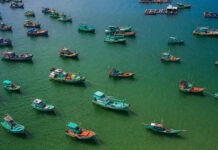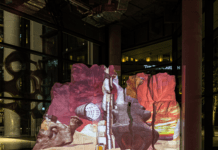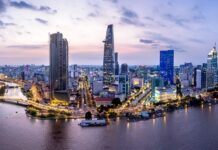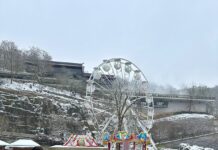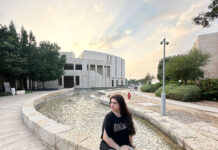Although Djibouti’s north is scattered with mountains ranging up to 2063 meters, and its 350 kilometers of coastline are lined with white sandy beaches and coral reefs, the country is dominated by a desolate volcanic desert. Fumaroles, vents from which volcanic gas escapes, spew from the desert’s insides; rocks are strewn across the wasteland like marbles on the baking asphalt of a playground. Much of the desert is actually below sea level and Lac Assal, at minus 155 meters, ranks as the world’s third-lowest point. Most of Djibouti’s lakes are saline and host incredible crystal formations: Lac Assal’s shore is carpeted with spheres of halite and angular gypsum, while Lac Abbe has towering deposits of travertine. The heat is only hospitable between November and mid-April, when easterly winds bring minimal rain and average temperatures of 25 degrees C. But come June, July and August, the mercury rises to 45 degrees C in the shade.

History in a nutshell
The discovery of basalt millstones near Lac Abbe has led some historians to believe agriculture may have been practiced in Djibouti as long as 4000 years ago. Two millennia later Djibouti became part of the Ethiopian Aksumite kingdom, which introduced Christianity before collapsing in the 7th century AD. Islam was brought in shortly thereafter by Arabian merchants who crossed the Red Sea. During the 16th century, successive Islamic leaders waged holy wars against Christian Ethiopia; while they failed to convert the Ethiopian highlands, Islam obtained a firm hold on Djibouti. The country then fell under first Ottoman and then Egyptian rule, until the French strolled onto the scene in 1862: they eventually established a successful port at what would become Djibouti City. Independence from France was finally achieved on 27 June 1977, becoming the last African mainland nation to do so. Since the end of its bloody civil war from 1991 to 1994, the country has remained stable.
People
Djibouti’s population is dominated by the Somali and Afar people, who make up 60 percent and 35 percent of the population respectively. The Somali, who occupy southern Djibouti, can be further divided into two clans: the Issa and the Issaqs (the term ‘Issa’ is often erroneously used to mean all Djiboutian Somalis). The Afar live in the north and are comprised of over 40 tribes, each historically linked to Ethiopia or Eritrea. Small French, Arab, Ethiopian and Italian populations make up the remainder of Djibouti’s population. Over 80 percent of the populations live in urban areas, with two thirds of the nation’s people living in Djibouti City alone. Almost 95 percent of Djibouti’s inhabitants are Sunni Muslim, although many nomads are not strictly orthodox.
Trademarks
- Port of Djibouti
- Red Sea
- Hostile deserts
- Camels and salt caravans
- Spherical Afar huts
Marketplace
Due to a lack of natural resources and industry, Djibouti’s economy is almost entirely dependent on its capital’s port, which provides transit services for the region and acts as an international trans-shipment and re-fuelling center. It continues to reap rewards from the Eritrean-Ethiopian conflict as the closure of the Ethiopia-Eritrea border means all Ethiopian foreign trade must go through the port. Services now account for an amazing 80 percent of GDP. Nevertheless, unemployment still sits around 50 percent and the nation relies heavily on foreign aid.
Natural Movements
Thanks to the fact that it sits directly above the meeting point of the diverging African, Somali and Arabian tectonic plates, Djibouti is currently, albeit very slowly, being ripped apart. In a few million years Djibouti will be no more, but until then, the volcanoes, sunken plains, salt lakes and fumaroles within this fascinating natural geological laboratory of a nation will be open for business.

Export
- The waters of Lac Assal and Lac Abbe, courtesy of evaporation
- Henna tattoos
- Afar fidama (woven straw mats)
- Traditional Afar or Somali knives

Myths & Legends
Although the bay of Ghoubbet al Kharab is considered one of the best places in the world to dive with whale sharks, its waters are feared by many Afar tribes-people. According to legend, one of the stark islands in these waters was crowned by fire until a horrendous deluge extinguished it one memorable day. Since then, many believe the depths have been patrolled by demons who drag all those who venture onto the water’s surface to the bay’s dark bottom —hence the name ‘Ghoubbet al Kharab’, which translates to ‘Devil’s Cauldron’. To this day, few people fish or visit these waters and even fewer set foot on the bay’s bleak islands.
Surprises
Despite the abundance and heavenly flavors of the local seafood, most Djiboutians do not care for it. Many Afar nomads still file their front teeth into ferocious-looking points.
It is surprisingly pricey to travel in Djibouti, compared to other African nations.
Essential Experiences
- Descending to the crystallized shoreline of Lac Assal to watch Afar tribesmen gathering salt
- Lingering on Lac Abbe’s ridiculously ‘lunar’ shoreline
- Searching for a rare Djibouti francolin in the shade of Mount Goda
- Following in the footsteps of nomads trekking the ancient salt route
- Floating in the midst of whale sharks and manta rays while diving in the Gulf of Tadjoura’s Ghoubbet al Kharab
- Soaking up the Arab feel of Tadjoura, a whitewashed coastal town fringed with palms
Best times to visit: November – Mid April


